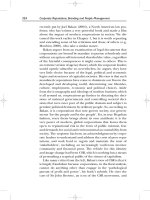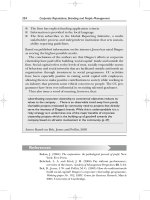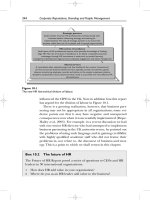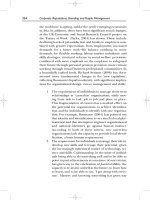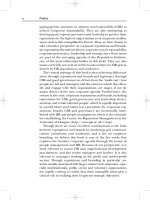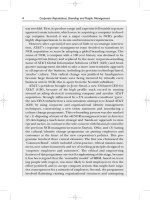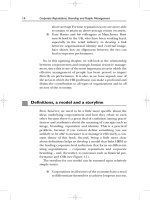Tài liệu Corporate Reputations, Branding and People Management 15 docx
Bạn đang xem bản rút gọn của tài liệu. Xem và tải ngay bản đầy đủ của tài liệu tại đây (124.76 KB, 10 trang )
124 Corporate Reputations, Branding and People Management
■ They arise from beliefs and perceptions of obligations
that, in the case of employees, are what they believe
they are entitled to as a consequence of perceived prom-
ises, either explicit or implicit, made by the employer
(Conway and Briner, 2005). In that sense, a psycho-
logical contract is more than just a set of expectations
that can arise in the absence of a promise. Only expec-
tations relating to perceived promises are entitled to be
considered as part of the psychological contract. Just
what these promises look like in practice and how they
arise are illustrated in Box 4.2. You can see how these
promises relate to official communications of the orga-
nizational identity and to leadership and governance.
Box 4.2 ‘Promises’ in the employment relationship that
create obligations
‘Promises’ arising from spoken and written communications:
■ strategic documents, employer commitments to certain courses of
action, mission and values statements, agreements, pledges, speeches
■ corporate brand values, ethics statements and social responsibility
policies, e.g. the kinds of statements on social responsibility and safety
made by companies such as BP and Shell, the client companies of
the offshore drilling contractors
■ employer branding/employer of choice policies (see Chapter 6)
■ financial statements or employer reporting statements
■ statements made on application forms, etc., by employees, and
employers’ advertisements, websites, etc., e.g. GE’s ecoimagination,
the drilling contractors’ promotional materials to employees
‘Promises’ arising out of behaviour and actions of leaders and managers:
■ observations of senior leadership, management or employee actions,
e.g. how managers and employees act in relation to one another in
treating each other with respect (see Box 4.1 for the perceptions of
how employees saw management style)
■ interactions with senior leaders, managers or employee representa-
tives, such as how recruiters behave during the interview process, or
as in the Offshore drilling case in Box 4.1, custom and practice on
standing men down during slack periods, or retaining people who
had been ‘good employees’ in the past
Breach and violation of psychological
contracts
Like legal contracts, psychological contracts can be breached or
violated if employees feel that the significant terms have been
broken, or that perceived obligations are unmet. The distinction
between breach and violation is largely one of degree; breaches
are treated as minor, usually short term and less significant,
whereas violations are seen as more serious, more long term
and significant in terms of outcomes. As an example, you might
want to reflect for a moment on whether employees in our off-
shore drilling industry survey saw elements of their psycholog-
ical contracts with the companies as met, breached or violated,
and what actions might help repair any damage.
It is to the violation of psychological contracts that many
researchers attribute major breakdowns in employee relations,
or failures in organizational change programmes. For example,
violation of psychological contracts has been used to explain
Chapter 4 The quality of individual employment relationships 125
Loyalty or silence
Non-response or willingness to
endure unfavourable
circumstances, perhaps because
there are no better alternatives
Exit strategy
Voluntary termination of the
relationship by leaving for
another job or exiting labour
market altogether
Exercise voice
‘Speaking up to power’ by
ignoring or defying bosses,
taking actions or expressing
comments, threats, etc. Or
attempts to build/rebuild trust
relationships
Neglect
May reflect passive negligence,
active destruction through
‘political’ behaviour or
sabotage. Or expressed through
cynicism towards management
promises
Positive Negative
Passive
Active
Figure 4.2
Range of employee responses to psychological contract violation (based
on Turnley and Feldman, 1998; Sutton, 2002, and others).
strike action and rises in absenteeism and employee turnover;
at the same time, violation has been used to explain rising lev-
els of cynicism about never-ending ‘programmes’ of organiza-
tional change and lack of trust in managers to ‘walk the talk’
(Pate et al., 2000).
One way of thinking about employee responses to contract
violation is to distinguish between active and passive ‘actions’ on
the one hand and positive and negative ‘actions’ on the other
(see Figure 4.2). Note how apparent loyalty or silence by employ-
ees may occur as a response to management actions that breach,
or even violate, expectations regarding promises. In one sense,
this can be treated as a positive response to changes managers
may make in the psychological contract because they have built
up a store of trust and a reputation for integrity in the past. But
it may also be seen as negative because employees endure what
they perceive as unfair treatment as they are unable to foresee
alternatives to their current employment. When the employ-
ment situation changes, however, they are very likely to adopt an
exit strategy if the breaches continue, as frequently happened in
the North Sea offshore drilling industry. A further implication of
this framework is that managers should do all they can to
encourage employees to ‘speak up to power’, rather than sup-
press discontent. Robert Sutton (2001) in an excellent account
of ‘weird ideas that really work’ promoted the notion that innov-
ating organizations should hire people that make them feel
uncomfortable and encourage others to ignore and defy their
superiors. By encouraging such actions, managers are not only
able to encourage innovation but can rebuild trust where it has
been broken, an essential component of employment relations.
This rebuilding of trust through sharing control with employee
representatives is one of the main justifications for encouraging
new forms of partnership agreements with trade unions. One of
the consequences of not doing so is the risk of employees adopt-
ing a negative, ‘neglect’ strategy, or even resorting to sabotage
(Pfeffer, 2005).
Predicting why and what happens when leadership and
management actions that, through design, accident or miscal-
culation, lead to breaches being treated as violations has been
studied by Conway and Briner (2002) and others (Martin et al.,
1998). They point to four characteristics of perceived promises
126 Corporate Reputations, Branding and People Management
that can have a major impact on employee responses to breach
or violation. They are:
■ the degree of explicitness of a perceived promise – the
more explicit the promise, e.g. communicating in mis-
sion statements, ‘people are our most important asset’;
the greater the sense of injustice and the more active –
positively or negatively – the employee response
■ attributions of personal responsibility for contract
breach or violation – the more personally responsible a
leadership team or individual managers’ reputations are
held to be for the perceived breach, the more intense
will be employees’ reactions, especially in trusting them
to act in employees’ best interests in the future
■ the unexpectedness or infrequency of the breach – the
more unexpected or infrequent the breach/violation
(a break with past behaviour), the more intense or
active the response will be from employees; again this
relates to what we learned about expectations of lead-
ership in Chapter 3 in the cases of HP and Agilent, and
Hurricane Katrina
■ the degree of importance the party attaches to the goal
or relationship breached – the greater the attachment
to the goal/relationship that is breached, the more
likely it will be treated as a significant violation and,
hence, provoke a negative response, for example the
Hurricane Katrina case.
Types of psychological contract
Though psychological contracts are individual in nature, result-
ing in as many contracts in an organization as there are employ-
ees, psychologists have tried to classify some of their more
general features. Three such classifications have emerged in the
extensive research in this area (e.g. Rousseau, 1995; Thompson
and Bunderson, 2003). These are set out in Table 4.3 and reflect
changes taking place in organizations and the wider economy.
During the 1990s in the USA, it was argued that the traditional,
relational contracts that many, mostly white-collar, employees
Chapter 4 The quality of individual employment relationships 127
held with their employers – based on commitment in return for
job security and career prospects – could no longer be sustained
because of increased global competition. Consequently, it was
suggested that this traditional, relational contract was being
128 Corporate Reputations, Branding and People Management
Table 4.3
Different types of psychological contracts.
Dimension Transactional Relational Ideological
Organizational Degree of job To provide a career Demonstrate credible
obligations security, safe with training and commitment to a
work and a education, promo- valued cause
‘fair day’s pay’ tion opportunities,
interesting work and
long term employ-
ment prospects
Individual ‘A fair day’s Go beyond contract Participate fully in
obligations work’ by doing excellent the organizational
work and demon- mission/cause by
strating high being a good
commitment and organizational
identification with and societal citizen
organization
Beneficiary Self Mutual interest The organization and
between self and employee share same
organization passion/cause
Based on beliefs Self-interested, Socialized employee, Principled
about human instrumental who is collectively involvement
nature, which worker who oriented and finds
are: works for satisfaction in work
money itself
Characteristics Black and white Grey areas which Grey (negotiable) but
of violation are negotiable also non-negotiable,
moral ‘hot-buttons’
Typical response Leave Withdraw commit- Principled
to violation organization ment and revert to a organizational
transactional exchange dissent
Basis of Compliance and Identification with Work as a calling
attachment to focus on the job organization and
work and career
organizations
Source: Based on Thompson and Bunderson, 2003, p. 575
